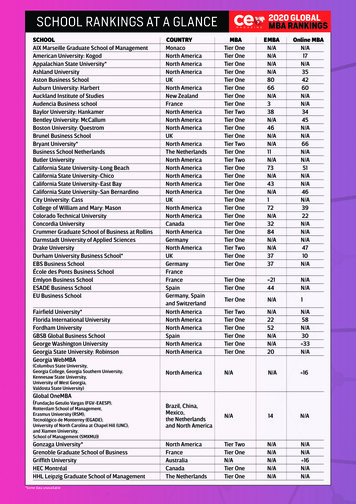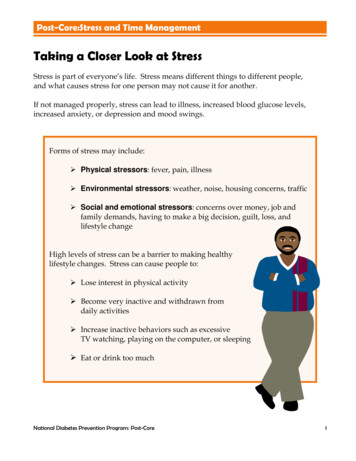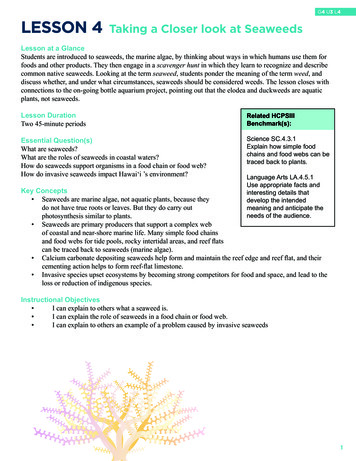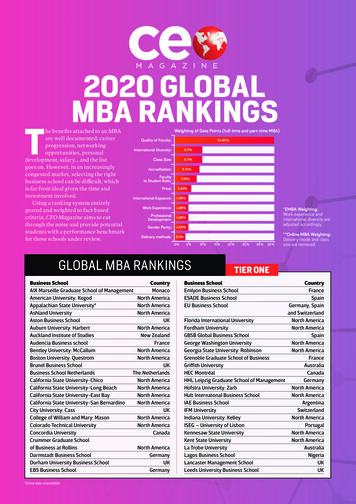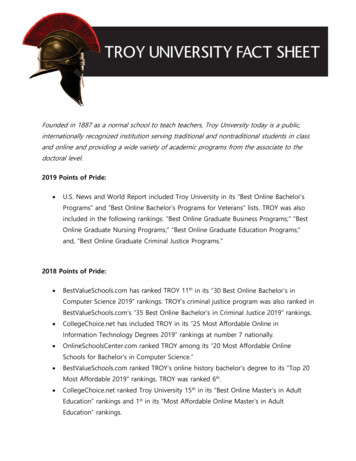
Transcription
University rankings guide:A closer look for research leadersUpdated: August 10, 2021Web version: versity-rankings-guideWhat are University Rankings?University rankings are diverse, imperfect — andinfluential.the chapter: Are university rankings flawed?Your university has a unique mission. You and yourcolleagues work hard to attract the right students, talent,and funding to ensure you can achieve it. You know youare doing a great job. But how do you communicate that tothe students, researchers, faculty members (and, in somecountries, policymakers and funding agencies) consideringyour university? They want to understand not only how youare performing but how your performance compares to yourpeers. Enter the world of university rankings.As the IREG Observatory on Academic Ranking andExcellence notes on their website, ranking organizationsshould:Rankings are not perfect, but usefulUniversity rankings and league tables are easily accessibleand provide a simple way to compare higher educationinstitutions based on similar criteria. But there is alwaysroom for improvement, and rankings are often the object ofcriticism, especially when conflated with reputation.Due to their limitations, you should not use rankings andleague tables as a stand-alone measurement. They are bestwhen used as decision-making tools in conjunction withother indicators and data. We explore this topic further inRankings are many, and not one size fits all“Recognize the diversity of institutions and takethe different missions and goals of institutionsinto account. Quality measures for researchoriented institutions, for example, are quitedifferent from those that are appropriatefor institutions that provide broad access tounderserved communities.”Understand Scopus and SciVal’s role in universityrankings.There are now more than 20 university ranking reports ororganizations with a global focus, and even more with aregional or discipline-specific rankings. Each university isunique in its mission and purpose; each ranking has itsniche, methodology, data sources and indicator. See thechapter “How are rankings calculated” for more detail.Read the latest version of this article online: versity-rankings-guide
The chart below offers a quick glimpse into the growth in international ranking organizations over time. It includes league tableslaunched to address the different types of universities and their missions.International ranking organizations and the year they were established.The chart above offers a quick glimpse into the growth in international ranking organizations over time. It includes league tableslaunched to address the different types of universities and their missions.Rankings are influentialRankings are often the go-to resource for students, parents, researchers, potential faculty members, funders, and other bodiesseeking an objective insight into your university’s performance and ability.Why do rankingsmatter?Listen in his own words.Over the past 18 years, international university rankings havegrown in visibility and prominence. They can influence: How your government measures research excellence foryour institution Whether an undergraduate or graduate student (and theirparents) opt for your university Why a company selects you as a partner Whether a funding body invests in research at youruniversityIn “Perspectives on rankings from a young university,” arecent episode of the Research 2030 podcast, César Wazen,Director of International Affairs, Qatar University, notes hisopinion on why rankings matter.You can hear more of Wazen’s insights in the entire episode.Although rankings are not the sole indicator of yourinstitution’s reputation and academic excellence, theyprovide a quantitative and popular way to benchmarkuniversities nationally, regionally, and globally.Rankings increase your university’s visibilitySince being ranked can increase your university’s visibilityand profile, it is a tool to promote your visibility. In turn,rankings help your audiences, e.g., students, potentialfaculty, potential collaborators and more.Read the latest version of this article online: versity-rankings-guide
Further, being ranked, regardless of your position, canoptimize your chances of being selected as a student’shigher education provider of choice.Watch the vido: An example of what prospectivesee when viewing rankings.Why rankings can play a role in attractinginternational studentsUntil recently, international students were a valuable incomesource for many higher education institutions. Universityrankings have long been a popular tool for those studentswhen choosing where to study, especially given that manydon’t have the time or funds to visit an overseas campusbefore enrolling. For some years, mainland China has beenone of the most significant sources of international students.For example, Chinese students make up the largest share(30%) of non-domestic students in the US.Although COVID-19 and geopolitical tensions may reducethe number of Chinese students opting to study overseas,the country’s dominance of the international student marketlooks set to continue. According to an article from QS, nearlyhalf (44%) admit that finding a well-ranked university iscrucial to them. High-quality teaching is their mostimportant consideration (60%), closely followed by havinga good reputation for their chosen subject (54%). These aretwo measures covered in the major university rankings.Source: www.universitiesuk.ac.ukAnd that will hurt university income. This graph byMultirank, an organization that compares universities,suggests that some countries will be harder hit than others,particularly Australia and the UK.Potential loss of total income (%) resulting from the decline ofinternational fee-paying students due to COVID-19. Source:MultirankFalling international student numbers also have financialimplications for your country or region. For example, in2019, the Association of International Educators (NAFSA)reported thatAs we can see in this Universities UK graph, by 2018, the USwas the most popular destination for international students,with the UK in second place. However, Australia’s stronggrowth before COVID-19 had left it ideally placed to takeover that number two spot.“.international students studying at US collegesand universities contributed 41 billion andsupported 458,290 jobs to the US economy duringthe 2018-2019 academic year.”But that looks set to change. Many predict that followinga tough 2020 for universities, 2021 will likely prove just aschallenging, with concerns over COVID-19 and ongoingtravel and visa restrictions negatively impacting internationalstudent numbers.In 2020, NAFSA reported that during the 2019-2020academic year, the financial contribution of 41 billion haddropped by 4.4% - a loss of 1.8 billion. The number ofsupported jobs fell by 9.2%.Competition for both domestic and international students isrising. Rankings, and your university’sposition within them, are likely toplay an increasingly important role.Source: BPC Calculations from theInternational Institute of Educationand The National Center for EducationStatistics, US Department of EducationRead the latest version of this article online: versity-rankings-guide
Who publishesUniversity Rankings?Rankings are developed and published by variousorganizations, including magazines, newspapers, websites,academics, and governments. Some ranking organizationsspecialize in world rankings, others in national or regional,and a few do both. This page concentrates on rankingorganizations with a global remit and research output focus.A brief history of global rankingsAccording to Hazelkorn’s article, “Global science, nationalresearch, and the question of university rankings,” in 2003,Shanghai Jiao Tong launched the Academic Ranking of WorldUniversities (ARWU), also known as the Shanghai Ranking.With the economy becoming increasingly global and highereducation more international, it was clear that a frameworkwas needed to map, compare, and understand universityperformance.From 2003 on, multiple ranking organizations and reportshave entered the arena, expanding options into how you cancompare Higher Education Institutions with greater varietyin niche reports.Two examples of this are:What are some of the key global rankingorganizations, and how do they differ?Quacquarelli Symonds (QS), Times Higher Education(THE) and Shanghai Ranking (the Academic Ranking ofWorld Universities; ARWU) are considered among the mostestablished and prominent global ranking bodies.Seven key global ranking reports to know are (inalphabetical order): CWTS Leiden Rankings Shanghai Rankings (ARWU) Times Higher Education World University Rankings Times Higher Education Impact Rankings QS World University Rankings QS World University Rankings by Subject US News & World Report: Best University RankingsCWTS Leiden Rankings The QS World Rankings’ University Rankings by Subjectlaunched in 2011: It considers varying research culturesand publication rates across academic disciplines. Times Higher Education’s (THE) THE Impact Rankingsintroduced in 2019: It is “a new global university rankingthat aims to measure institutions’ success in delivering theUnited Nations’ Sustainable Development Goals.”From The Economist:“The rankings race is thus marked by a happyirony. Driven in part by nationalistic urges, it hasfostered the growth of a community that knowsno borders. Critics are right that governmentsand universities obsess too much about rankings.Yet the world benefits from the growth of thisproductive, international body of scholars.”Source accessed July 28, 2020: https://www.economist.comFocus: Research-intensive universitiesScope: 1,000 institutionsTiming: Annually (June)Stated goal: The Leiden Ranking stands for amultidimensional perspective on university performance.Data sources: Web of Science data from the Science CitationIndex Expanded, the Social Sciences Citation Index, and theArts & Humanities Citation Index, which is then enrichedby CWTS. Excludes conference proceeding publications andbook publicationsMethodology: The Leiden Ranking provides informationexclusively about the research done at universities. Theyoffer important insights into the scientific performanceof nearly 1000 major universities worldwide. Research isrepresented in publications, and the collected data aboutthese publications forms the basis for the Leiden Ranking. Aset of bibliometric indicators are used to provide statistics onscientific impact, collaboration, open access publishing, andgender diversity.Read the latest version of this article online: versity-rankings-guide
Identification of universities: Typically, a university ischaracterized by a combination of education and researchtasks in conjunction with a doctorate-granting authority.However, these characteristics do not mean that universitiesare particularly homogeneous entities that allow forinternational comparison on every aspect. As a result of itsfocus on scientific research, the Leiden Ranking presentsa list of institutions that have a high degree of researchintensity in common.These indicators include:WUR by SubjectFocus: Individual subject areas (48)Scope: 1,000 institutionsTiming: Annually (Spring) Open access indiatorsStated goal: Help prospective students identify the world’sleading schools in their chosen field in response to highdemand for subject-level comparisons. Size-dependent vs. size-independent indicatorsData sources: Gender indicators International Reputation Scientific impact indicators QS global survey of academics Counting method QS global survey of employers Collaboration indicators Research impact: Elsevier’s Scopus database Trend analysis Research citations per paper Stability intervals h-index in relevant subjectWorld University RankingsMethodology: Four components are combined to producethe results for each of the subject rankings, with weightingsadapted for each discipline: Publications Academic reputation Employer reputation Research citations per paperFocus: GlobalScope: 1,500 institutionsTiming: Annually (Spring)Stated goal: For students seeking to understand how theirprospective university choices are perceived by the globalacademic community, and by potential employers across theworld.Data sources: Elsevier’s Scopus databaseMethodology: QS uses a consistent methodologicalframework, compiled from six simple metrics to captureuniversity performance. Faculty area normalization wasintroduced in 2015 to ensure that institutions specializingin Life Sciences and Natural Sciences were not undulyadvantaged, QS has avoided fundamental changes, with theaim to provide a consistent year-on-year comparison.QS World University Rankings evaluatesuniversities according to six metrics: h-indexAs research cultures and publication rates vary significantlyacross academic disciplines, the QS World UniversityRankings by Subject applies a different weighting of the fourindicators in each subject.For example, in medicine, where publication rates are veryhigh, research citations and the h-index account for 25%of each university’s total score. On the other hand, in areaswith much lower publication rates such as history, theseresearch-related indicators only account for 15% of the totalranking score. Meanwhile, in subjects such as art and design,where there are too few papers published to be statisticallysignificant, the ranking is based solely on the employer andacademic surveys.Shanghai RankingsFocus: GlobalScope: 1800 institutions are ranked annually, top 1000 arepublishedTiming: Annually (August)Stated goal: Provide a starting point for identifying nationalstrengths and weaknesses as well as facilitating reform andsetting new initiativesRead the latest version of this article online: versity-rankings-guide
Data sources: Nobel Prize Fields Medals (www.mathunion.org) HiCi: Clarivate N&S: Web of Science Bibliometrics: Web of Science Number of academic staff: National agencies suchas National Ministry of Education, National Bureauof Statistics, National Association of Universities andColleges, National Rector’s Conference.Methodology: The highest scoring institution is assigneda score of 100, and other institutions are calculated as apercentage of the top score. An institution’s rank reflects thenumber of institutions that sit above it. 10% Quality of Education: Alumni of an institutionwinning Nobel Prizes and Fields Medals 20% Quality of Faculty: Staff of an institution winningNobel Prizes and Fields Medals 20% Quality of Faculty: Highly Cited Researchers 20% Research Output: Papers published in Nature andScience*Focus: GlobalScope: 1,400 institutionsTiming: Annually (September)Stated goal:Evaluate research-intensive universities across all theircore missions: teaching, research, knowledge transfer andinternational outlook.Provide trusted performance data on universities forstudents and their families, university academics, universityleaders, governments and industryData sources: Academic Reputation Survey Elsevier’sScopus databaseMethodology: THE uses 13 performance indicators toposition more than 1,400 institutions worldwide. Theseperformance indicators are grouped into five areas (as shownto the right). 30% Teaching (the learning environment): 15.0% Reputation survey 4.50% Staff-to-student ratio 2.25% Doctorate-to-bachelor’s ratio 6.00% Doctorates-awarded-to-academic-staff ratio 20% Research Output: Papers indexed in Science CitationIndex-Expanded and Social Science Citation Index 2.25% Institutional income 10% Per Capita Performance: Per capita academicperformance of an institution 18% Reputation survey* For institutions specialized in humanities and socialsciences such as London School of Economics, N&S is notconsidered, and the weight of N&S is relocated to otherindicators. 6.0% Research productivity 30% Research (volume, income and reputation): 6.0% Research income 30% Citations (research influence) 7.5% International outlook (staff, students and research) 2.5% Proportion of international students 2.5% Proportion of international staff 2.5% International collaboration 2.5% Industry income (knowledge transfer)World University RankingsRead the latest version of this article online: versity-rankings-guide
World University Rankingsefforts not covered in other rankings and demonstrate thedifferences a university is making to the world we livein.Data sources: Universities can submit data on as many of the 17 SDGs asthey are ableFocus: GlobalScope: 1,400 institutionsTiming: Annually (September)Stated goal:Evaluate research-intensive universities across all theircore missions: teaching, research, knowledge transfer andinternational outlook.Provide trusted performance data on universities forstudents and their families, university academics, universityleaders, governments and industryData sources: Academic Reputation Survey Elsevier’sScopus databaseMethodology: THE uses 13 performance indicators toposition more than 1,400 institutions worldwide. Theseperformance indicators are grouped into five areas (as shownto the right). 30% Teaching (the learning environment): 15.0% Reputation survey 4.50% Staff-to-student ratio 2.25% Doctorate-to-bachelor’s ratio 6.00% Doctorates-awarded-to-academic-staff ratio 2.25% Institutional income 30% Research (volume, income and reputation): 18% Reputation survey 6.0% Research income 6.0% Research productivity 30% Citations (research influence) Elsevier’s Scopus databaseHow universities are ranked:THE uses indicators to provide comparisons across threebroad areas: research, outreach, and stewardship, across allof the SDGs. Any university that provides data on SDG 17 andat least three other SDGs is included in the overall ranking.The methodology was developed in conjunction with THE’spartners Vertigo Ventures and Elsevier, and after consultationand input from individual universities, academics, and sectorgroups. Universities can submit data on as many of theSDGs as they are able. Each SDG has a series of metrics thatare used to evaluate the performance of the university in thatSDG. As well as the overall ranking, THE also publishes theresults of each individual SDG. This rewards any universitythat has participated with a ranking position, even if they arenot eligible to be in the overall table.Methodology:A university’s final score in the overall table is calculated bycombining its score in SDG 17 with its top three scores outof the remaining 16 SDGs. SDG 17 accounts for 22% of theoverall score, while the other SDGs each carry a weight of26%. This means that different universities are scored basedon a different set of SDGs, depending on their focus.The score from each SDG is scaled so that the highest scorein each SDG in the overall calculation is 100. This is to adjustfor minor differences in the scoring range in each SDG andto ensure that universities are treated equitably whicheverSDGs they have provided data for. It is these scaled scoresthat we use to determine which SDGs a university hasperformed most strongly in; they may not be the SDGs inwhich the university is ranked highest or has scored highestbased on unscaled scores 7.5% International outlook (staff, students and research) 2.5% Proportion of international students 2.5% Proportion of international staff 2.5% International collaboration 2.5% Industry income (knowledge transfer)Impact RankingsFocus: United Nations’ Sustainable Development Goals(SDGs)Scope: 768 institutions (changes annually)Timing: AprilBest University RankingsFocus: GlobalScope: 1,500 institutions across more than 80 countriesTiming: Annually (October)Stated goal: To provide a showcase for the work beingdelivered by universities in our communities, and anopportunity to shine a light on institutional activities andRead the latest version of this article online: versity-rankings-guide
Stated goal: For potential students: used to explore higher educationoptions beyond their own countries’ borders and tocompare key aspects of schools’ research missions. For universities: provide a way to benchmark themselvesagainst other schools, become more visible globally, andfind top schools in other countries to collaborate with.Data sources: Bibliometric data and indicators: Web of Science andInCites Reputation Indicators: Clarivate Analytics’ AcademicReputation SurveyMethodology: The rankings focus specifically on schools’academic research and reputation overall and not on theirseparate undergraduate or graduate programs. To arrive at aschool’s rank, the overall global scores are calculated usinga combination of the weights and z-scores for each of the 13indicators used in the rankings.How are universities ranked?Before we dive into how the rankings organizationcalculates their rankings, remember they differ significantlyin methodology and evolve year to year. They have theirlimitations and shouldn’t be used in isolation to assessreputation or excellence.As Lydia Snover, Director of Institutional Research at theMassachusetts Institute of Technology, commented in aTimes Higher Education (THE) blog post“Let me be clear: there is no such thing as aperfect university ranking. There is no ‘correct’outcome as there is no single model of excellencein higher education, and every ranking is basedon the available, comparable data, and is builton the subjective judgement (over indicators andweightings) of its compilers.”Why is it important to understand methodologiesThe focus area(s), algorithms and methodologies vary acrossthe growing number of ranking tables and reports producedworldwide. Once you grasp the inner workings, you willunderstand how your practices and data can impact thatranking’s outcome. We look at this in more detail in thechapter: Can I influence university rankings?All ranking methodologies rely on data inputs from a rangeof external resources. These often include the three exampleslisted below. Still, much depends on the niche and focusof that particular league table. Similarly, the weighting andcalculations selected for each element will depend on thereport’s specific direction. Your university’s institutional data and researcher data(based on research output) from bibliometric or citationindexing databases, such as Scopus Data drawn from university departments such as humanresources, student administration, finances Reputation surveys conducted with faculty, students,alumni, and employersMost ranking organizations’ websites offer some detail abouttheir methodology to help you understand their focus andthe data and information used to inform their results.Where can I find information on the calculationsand weighting used?Please see the lists above or download the quick guide.Where do ranking organizations get their dataand information?Read the latest version of this article online: versity-rankings-guide
Are university rankingsflawed?According to critics, the answer is yes! They claim thatcurrent systems: Are based upon flawed data assumptions Negatively impact student school selection Exclude data important to students Fail to consider the mission of the university Stifle individuality and creativityWhy are the university rankings calculations soproblematic?use to judge themselves are not in thevarious calculations. These include openscience, equality, diversity and othersociety-focused agendas.On the Malcolm Gladwell podcast,Revisionist History, in the episode“Project Dillard,” he speaks withWalter M. Kimbrough, President ofs, a US Historically Black College and University (HBCU).Kimbrough describes his college as one that wants toeducate as many people as the can. Yet, the fact that theirmission includes teaching an economically disadvantagedlowers their rank.Many ranking organizations actively work with universitiesand third-party entities to learn, evolve, and adapt theirmodels. As technology, transparency and understandingimprove, so will university rankings.Ellen Hazelkorn, a global rankings researcher, states inthe article, University Rankings: there is room for errorand ‘malpractice’”, believes university rankings are popularbecause they are simple. However, “ this is also the mainsource of criticism.” No single ranking can capture the fulldepth and breadth of a university’s contributions.What is the future foruniversity rankings?For Hazelkorn, issues include:Most agree that rankings are here tostay. But will they evolve to addresssome of the concerns raised in thechapter: Are university rankings flawed?In the future, we expect to see Their lack of objectivity: Ranking organizations determinethe indicators and weightings that are most important. Their priorities: Most rankings consider attributes forwhich (internationally) comparable data are available,typically research and reputation. There is little or nofocus on other vital areas, such as student and societalengagement or even teaching and learning.Many feel that rankings rely too muchon “proxies,” for example some usefactors like the number of Nobelprize-winning alumni or the valueof endowments when determiningeducation quality. Others claimalgorithm bias, with some institutionsalways at the top, including thosepublishing in English. Others point to the fact that theplacement of a university can vary wildly per rankingorganization.Here is Josh Wyner, Founder and Executive Director ofthe College Excellence Program at the Aspen Institute,discussing rankings that focus on student outcomes.“They don’t typically give colleges rewards forequity: for keeping their doors as open as possible.Nor do they look at how much students grow whilethey are at college. If you don’t look at wherethey enter or how likely they are to achieve thoseoutcomes – given how well-prepared they wereand how wealthy they were when they enteredcollege – you may be distorting the picture.”Rankings: what do they mean for universities on amission? Shifts in methodology in response toCovid-19 A rise in more focused rankings A move beyond traditional measures Increasing use of third-party data and AI technologiesThe pandemic and global rankings – what willCovid-19 change?Potentially, quite a lot. Rankingorganizations are still consideringtheir response to the pandemic.Some plan to take a fresh look at theirmethodology to acknowledge thevirus’ impact on teaching and learning,collaboration, and internationalstudents. Some wonder how to accountfor the rapid rise in some universities’ publications linked toCovid-related research.As Elizabeth Gadd of INORMS said in the March 2021 article“Measure what matters: Ranking universities in the age ofpandemic,”What we are finding with all sorts of research evaluationissues is that the pandemic is not going to impact in the next12 months. It’s going to be impacting over the next ten years.Some believe the popularity of global rankings may dip asprospective students, faced with potential travel restrictionsand a tighter budget, turn to national and regional rankingsinstead.For mission and value-led organizations, university rankingscan be particularly problematic since the principles theyRead the latest version of this article online: versity-rankings-guide
Do we need so many university rankings?The world is changing, and so are universities. Existingrankings organizations have responded with new tablesthat rank universities by subject area, geographic location,societal contribution, or degree types.We’ve also seen new organizations dip a toe into therankings market. The Three University Missions MoscowInternational University Ranking claims to be the first toevaluate education, research and interaction with society.But more indicators and rankings equals more datacollection for universities, and countries with fewer resourceswill suffer, according to rankings expert Richard Holmes in“Universities in places like Africa will not allocate resources toreport data.”To solve this problem, QS believes we could see rankersincrease their use of third-party data. They may even turn toexternal organizations “to produce objective and accurate datafor analysis.” Using this kind of data could help address theclaim that current methodologies often lack transparency.Additionally, by adopting artificial intelligence technologies,for example, natural language processing (NLP), the burdenon data collection could decrease.Is it time to expand the rankings’ indicators?The previous section, Are university rankings flawed? makesclear that many believe that rankers should stop focusing onreputation or traditional research metrics and start includingother kinds of measures. For example: Article usage Media and social media mentions, Citations in policy or clinical documentsWe also expect to see a greater focus on societalcontributions. Currently, Times Higher Education (THE)Impact Rankings assesses universities against the UnitedNations’ Sustainable Development Goals (SDGs).Perhaps the key is to step away from the concept of “ranking”altogether. In the Research 2030 podcast episode “SocietalImpact, SDG Research & Universities: A conversation withProfessor Aluísio Segurado of University of São Paulo,”Segurado, Head of Research at the Brazilian university,suggests taking a more multidimensional approach. Hebelieves this will not only support comparative analysis buthelp universities identify collaborators.Listen in his own words.Can I influenceuniversity rankings?Wit
Shanghai Jiao Tong launched the Academic Ranking of World Universities (ARWU), also known as the Shanghai Ranking. With the economy becoming increasingly global and higher education more international, it was clear that a framework was neede

